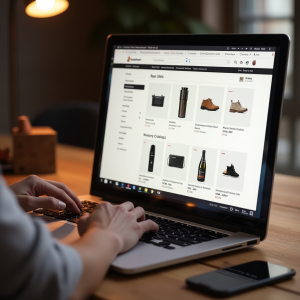SEO and Dropshipping
I’ve been in the dropshipping game for years now. One thing I’ve learned? SEO is a game-changer. Search Engine Optimization helps your store appear higher in search results. This means more visitors without paying for ads. My dropshipping business skyrocketed once I mastered SEO basics.

In this guide, I’ll share my best SEO strategies for dropshipping. You’ll learn how to research keywords, optimize product pages, and build quality backlinks. I’ll keep it simple and practical. Let’s turn your dropshipping store into a traffic magnet!
Understanding SEO Basics
SEO isn’t complicated once you break it down; in fact, it’s about making your store visible to search engines like Google. In other words, I think of it as putting up digital signposts that lead customers to my store.
There are three main types of SEO I focus on:
- Firstly, On-Page SEO covers everything on my website—product descriptions, titles, and images.
- Secondly, Off-Page SEO involves building my site’s reputation through backlinks.
- Lastly, Technical SEO ensures my site loads fast and works well on all devices.
By contrast, unlike paid ads that stop working when you stop paying, SEO brings consistent traffic. As a result, I’ve found it to be the most cost-effective marketing strategy for my dropshipping business. Interestingly, over 50% of website traffic comes from organic search results, not paid advertisements. Therefore, this highlights the importance of optimizing for search engines.
Why SEO Matters for Dropshipping
When I started my dropshipping business, I wasted money on ads. Eventually, I discovered SEO. Here’s why it’s perfect for dropshipping:
It’s Cost-Effective
To begin with, I don’t pay for each visitor. Once my SEO is established, I get traffic for free. As a result, this helps my profit margins tremendously. In this way, I can now compete with bigger stores despite my smaller budget.
It Builds Trust
Furthermore, people trust Google’s search results. When my store appears on the first page, customers automatically trust me more. Consequently, I’ve noticed higher conversion rates from organic traffic compared to paid ads.
It’s Long-Lasting
What’s more, my SEO efforts from a year ago still bring me traffic today. In contrast to social media posts that disappear quickly, good SEO continues working for months or years. Therefore, this gives me stable traffic even when I’m not actively marketing.
Keyword Research for My Dropshipping Store

Keyword research was my first step to SEO success. I needed to find what my potential customers were searching for.
Finding My Niche Keywords
I started by identifying my specific niche within dropshipping. I sell fitness equipment, so I needed relevant keywords. I use several tools:
- Google Keyword Planner: Shows me search volumes for free
- Ubersuggest: Offers keyword ideas and competition data
- SEMrush: Helps me see what keywords my competitors rank for
I look for a sweet spot – keywords with decent search volume but lower competition. These are easier to rank for when starting out.
Focusing on Long-Tail Keywords
The biggest SEO breakthrough for my store came from targeting long-tail keywords. These are longer, more specific phrases. Instead of targeting “yoga mats,” I target “eco-friendly non-slip yoga mats for hot yoga.”
Long-tail keywords bring fewer visitors but they convert better. These searchers know exactly what they want. When my product matches their specific search, they’re more likely to buy.
Understanding Search Intent
I always consider why someone is searching. Are they ready to buy? Just researching? I match my content to their intentions.
For example, someone searching “best yoga mats for beginners review” is still researching. I create informative content for them. Someone searching “buy purple yoga mat with strap” is ready to purchase. I optimize product pages for these terms.
Optimizing My Product Pages

My product pages are my most valuable real estate. Here’s how I optimize them:
Writing Original Product Descriptions
To begin with, I never copy descriptions from suppliers. Instead, I write unique, detailed descriptions for each product. For maximum impact, I include the main keyword naturally within the first 100 words. Moreover, I focus on benefits, not just features.
For example, rather than just saying “silicone yoga mat,” I write “non-slip silicone yoga mat that stays in place during the most intense poses.” Additionally, I aim for at least 300 words per product description. This way, I have enough room to include variations of my keywords naturally.
Optimizing Title Tags and Meta Descriptions
Furthermore, for each product, I create a compelling title tag under 60 characters. I always include my main keyword near the beginning.
Similarly, my meta descriptions act like mini-advertisements. I keep them under 160 characters and include a call to action like “Shop now with free shipping!” As a result, this improves my click-through rates.
Image Optimization
Product images are crucial for my store. In this regard, I follow these steps:
- First, I rename image files with descriptive, keyword-rich names before uploading.
- Next, I add alt text to every image, describing what’s shown while including keywords.
- Then, I compress all images to keep page loading speeds fast.
- Finally, I use high-quality, original product photos whenever possible.
Altogether, these small changes have significantly improved my image search traffic.
Building Backlinks to My Store
Backlinks are votes of confidence for my store. Here’s my approach:
Quality Over Quantity
I focus on getting links from relevant, authoritative websites. One link from a popular fitness blog is worth more than twenty links from random sites. I avoid buying links as this can get my site penalized.
My Best Link-Building Strategies
These strategies have worked well for my dropshipping business:
- Guest posting: I write helpful articles for fitness blogs and include a link to my store
- Product reviews: I send free products to influencers in exchange for honest reviews
- Resource pages: I find websites with resource lists and suggest my content
- HARO (Help A Reporter Out): I sign up as a source and provide expert quotes
I focus on creating relationships, not just getting links. This has led to ongoing partnerships that continue to benefit my store.
Technical SEO Improvements
Technical SEO might sound intimidating, but I’ve mastered the essentials:
Speeding Up My Website
Slow sites kill conversions. I’ve made these improvements:
- Compressed all images
- Minimized code (CSS, JavaScript)
- Used browser caching
- Upgraded to faster hosting
I use Google PageSpeed Insights to test my site regularly. My pages now load in under 2 seconds, which has reduced my bounce rate significantly.
Mobile Optimization
Most of my customers shop on mobile devices. I ensure my site looks perfect on all screen sizes. I’ve implemented:
- Responsive design that adapts to any screen
- Large, easy-to-tap buttons
- Simple navigation menus
- Readable text without zooming
Google uses mobile-first indexing, so this is non-negotiable for good rankings.
Secure Website
I installed an SSL certificate to make my site HTTPS. This shows a lock icon in browsers and builds trust. Google also gives a small ranking boost to secure sites.
Content Marketing Strategy
Blog content has transformed my dropshipping business. It brings in traffic for informational keywords my product pages can’t target.
Creating Valuable Content
I publish these types of content regularly:
- How-to guides: “How to Choose the Perfect Yoga Mat for Your Practice”
- Comparison articles: “Foam vs. Cork Yoga Mats: Which is Right for You?”
- Problem-solving posts: “5 Ways to Clean and Maintain Your Yoga Mat”
Each article targets specific keywords while providing genuine value. I include internal links to relevant products naturally within the content.
Consistency is Key
I publish new content every week. This regular schedule keeps search engines coming back to index my site. I focus on quality over quantity. One excellent article brings more traffic than five mediocre ones.
Social Media Integration
Social media complements my SEO efforts perfectly:
My Platform Strategy
I focus on platforms where my target audience is active. For my fitness equipment store, Instagram and Pinterest work best. I don’t spread myself thin across every platform.
I share my blog content, product highlights, and user-generated content consistently. I use relevant hashtags to extend my reach. While social media doesn’t directly impact rankings, it drives traffic and increases brand awareness.
Leveraging Influencer Marketing
I work with fitness influencers who have engaged followers. They create authentic content featuring my products. This drives targeted traffic and sometimes earns valuable backlinks when influencers mention my store on their blogs.
Tracking My SEO Performance
I can’t improve what I don’t measure. Here’s how I track my SEO performance:
Essential Tools I Use
- Google Analytics: Shows me where visitors come from and how they behave
- Google Search Console: Tells me which keywords bring traffic and identifies technical issues
- Ahrefs: Monitors my backlink profile and tracks keyword rankings
I check these tools weekly to spot trends and opportunities.
Key Metrics I Track
I focus on these metrics:
- Organic traffic growth: Are more visitors finding me through search engines?
- Conversion rate from organic traffic: Are these visitors buying?
- Keyword rankings: Are my target keywords moving up in search results?
- Backlink quality and quantity: Is my site’s authority growing?
When I notice issues, I take immediate action. This proactive approach keeps my SEO results improving month after month.
Avoiding Common SEO Mistakes
I’ve made plenty of mistakes along the way. Learn from them:
Technical Mistakes I’ve Fixed
- I used to have duplicate product pages with slightly different URLs
- My site was painfully slow on mobile devices
- I had broken links throughout my site
Fixing these technical issues gave my rankings an immediate boost.
Content Mistakes to Avoid
Don’t copy supplier descriptions like I initially did. Google penalizes duplicate content. Don’t stuff keywords into your text. Write naturally for humans first, search engines second.
Backlink Mistakes
I once bought cheap backlinks from a sketchy service. My rankings actually dropped! Focus on earning quality links through valuable content and relationships.
Conclusion
SEO has transformed my dropshipping business. It brings me consistent, targeted traffic without ongoing advertising costs. The key is patience and persistence. SEO isn’t an overnight success strategy, but the long-term benefits are worth the effort.
Start with thorough keyword research. Create unique, valuable content for your products and blog. Ensure your site loads quickly and works well on all devices. Build quality backlinks through relationships and valuable content.
Monitor your results and continuously improve. Within a few months, you’ll see your traffic and sales grow steadily. SEO might seem complex at first, but these fundamentals will put you ahead of most dropshipping competitors who rely solely on paid traffic.

